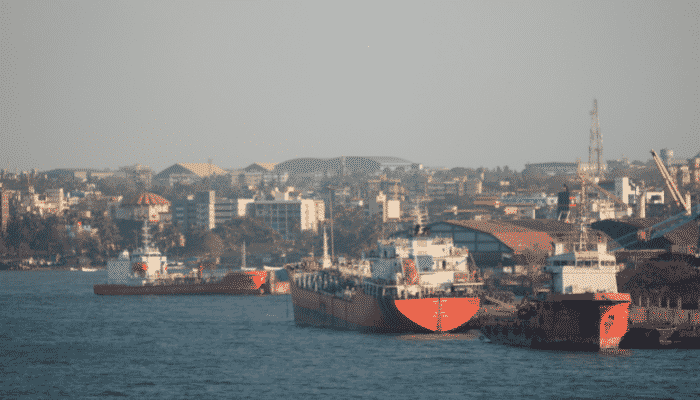What are Dedicated Freight Corridors (DFC)?
India has for long not performed to its potential in the global economy and international trade, with its share of international trade being grossly incommensurate with its population and abundance of natural resources.
Further, the cost of transportation and ease of doing business was impacted by lack of competitiveness in terms of manufacturing and trade, inadequate export orientation and infrastructure constraints.
In the past decade or so, the government has set its sights firmly on elevating India’s position as an economic powerhouse, in line with its ambitions of being counted amongst the prominent nations on the world stage.
Working towards alleviating the root causes hampering India’s Export trade, the Government has launched a slew of initiatives, aimed at incentivising manufacturing and exports, bolstering the overall infrastructure, having in place reliable transport chains and ensuring global connectivity.
One of the more high profiles and pivotal initiatives thereunder is the construction of Dedicated Freight Corridors (DFC), which essentially involve the development of dedicated rail transport corridors connecting gateway ports to the primary hinterlands, aligned with corresponding investments in ancillary trade-enabling facilities, with the ultimate objective being the construction of a complete business eco-system, geared towards encouraging and supporting manufacturing and trade.

Dedicated Freight Corridors (DFC) – Background and Rationale
Most EXIM cargo or containers are transported to hinterlands, with Rail and Road being the two primary modes for inland transportation.
Of the two, Rail is generally the preferred option, since it is cost-effective and also environment friendly, especially for the movement of cargo over long distances.
Indeed, in most developed countries, the Rail mode accounts for the majority of cargo hauled inland, while Road transport is restricted for shorter distances.
In India however, the situation is reversed, with Road being the prevalent mode even for longer distances.
While under-investment in the Rail network and maintenance is one of the primary factors, the issue is considerably exacerbated by the existing policy, which prioritises passenger movement over the carriage of freight, despite the fact that freight transport is more profitable than passenger traffic.
Given that both passengers and cargo are ferried using the same rail tracks, this effectively means that freight trains have to give way to passenger trains, with the consequent waiting times causing delays, prolonging transit times and higher costs – in terms of carrying buffer inventory, missed sales, slower turnover, greater risk of damage, pilferage, obsolescence etc).
While a certain proportion of cargo did shift from road to rail in the past decade or so, Road still remains the predominant mode due to the challenges explained above.
The DFC initiative is an endeavour to eliminate the underlying root cause and drive a multi-modal shift favourably balanced towards Rail, through the provision of dedicated rail lines for freight, which will ensure reliable and safe services, operating in accordance with published schedules, thereby reducing costs and inland transit times.
What is the DFC project?
The Government of India, through the Indian Railways, has incorporated an entity named Dedicated Freight Corridor of India Limited (DFCCIL), a Special Purpose Vehicle (SPV), whose primary objective was the construction of Dedicated Freight Corridors, spanning the length and breadth of the country, with the objective of ensuring fast and reliable rail connections between the major gateway ports in coastal areas, and the primary consumption and population centres in the North Indian hinterland.
The project consists of 6 corridors, crisscrossing the entire country, listed below:
Work has been ongoing on the Western Dedicated Freight Corridor (connecting the states of Haryana, Uttar Pradesh, Rajasthan, Gujarat and Maharashtra) and the Eastern Dedicated Freight Corridor (connecting the states of Punjab, Haryana, Uttar Pradesh, Bihar, Jharkhand and West Bengal) for a few years now and they are presently partly operational, with cargo being carried on certain sections of these two corridors.
The Indian Government has partnered with the World Bank and the Japan International Co-operation Agency (JICA), which have funded the construction of certain sections of the EDFC and WDFC respectively.
The remaining 4 corridors are still in the planning stage, with groundwork yet to commence thereupon.
These corridors are amongst the busiest freight corridors in India and are sometimes referred to as the Golden Quadrilateral Freight Corridor (GQFC).
Once commissioned, they are cumulatively expected to carry 70% of commercial freight, significantly easing the burden on regular track lines and improving the speed and reliability of passenger transport.
Since the majority of container traffic moves from gateway ports located along the West coast of India (Nhava Sheva, Mundra, Hazira, Pipavav and Kandla), to the biggest consumption centres in North India, the Western Dedicated Freight corridor will primarily cater to the movement of containerised cargo.
As far as the Eastern Dedicated Freight Corridor is concerned, since the largest mines and natural resource belts are located in or relatively proximate to the Eastern coast of India, the Eastern Dedicated Freight Corridor is intended to serve this cargo.
Impact and Benefits of DFC
The DFC initiative is expected to bring about a paradigm shift in the Rail Freight market in India, which will cascade down to the Passenger transport market as well.
The targeted shift of 70% of freight movement from normal rail tracks to the dedicated freight lines will free up tracks for better utilisation and service enhancements for passenger traffic, creating potential revenue generation opportunities therefrom.
Some of the primary benefits are enumerated hereunder:
- Faster and reliable movement of cargo, leading to lower transport costs and reduction in overall TCO (Total Cost of Ownership)
- Boost to manufacturing activities and export trade
- Average train speed increased from the current 25 kms per hour to 70 kms per hour – leading to faster deliveries and lower inventory requirements
- Capacity to carry heavier loads of 13,000 tonnes
- The higher proportion of cargo moved via the environment-friendly Rail mode (target of 45%, from the existing 30%), resulting in lower emissions
- Lowering of India’s Logistics Costs as a proportion of the total GDP, from the current 14%-15%, to closer to the 8% target set by the Government
Challenges of DFC
The prolonged delays and cost overruns that have plagued the DFC programme amply illustrate the challenges involved in commissioning a project on this scale, in a large and populous country like India.
Some of the major challenges have been explained below:
Cost overruns: When the project was accorded in-principle approval in 2007, the budgeted cost was estimated at Rs 28,000 crores, which had ballooned to Rs 81,000 crores in 2015. As of the end of 2020, the projected investment had swelled to approximately Rs 95,000 crores.
Land acquisition challenges: Since the proposed routes run through heavily populated areas in some stretches (especially near Nhava Sheva port), the acquisition of land has been a major stumbling block, causing severe delays for many years since inception.
In the last couple of years, with greater Government focus and increased engagement between local authorities and the affected section of the population, most such issues have been resolved by providing monetary remuneration and alternate land parcels.
Deep integration of Road transport in existing supply chains of exporters and importers: Given the dominance of road transport over the years, all manufacturers, exporters and importers have developed their supply chains revolving around the road mode.
The interdependence and interlinkages between road transport and other parts of their supply chain mean that shifting from Road to Rail will entail redesigning the entire supply chain, requiring significant resources, time and effort.
It is therefore conceivable that the anticipated shift from Road to Rail will take considerably longer than expected, prolonging the gestation period of the DFC’s.
Conclusion
As is to some extent inevitable in the case of projects as ambitious and broad in scope as the DFC, delays and cost overruns have piled up over the years, with work proceeding at a tardy pace.
In the past 2 years, however, most constraints have been eliminated and certain sections of the corridors made operational.
Trial runs have already been conducted smoothly, assuaging concerns about quality and further prolonged delays.
The land acquisition still remains a challenge, as even though the majority of land has been required, the pending land is not contiguous but spread over several stretches, worsening the complexity and number of stakeholders to deal with.
Considering however that the local authorities have been engaging intensively with landowners, it would be reasonable to expect a resolution in the near future.
It might take some time for Exporters and Importers to shift from Road to Rail but given the undeniable long term benefits that would accrue therefrom, it is only a matter of time until such a shift and realignment of supply chains takes place.
Besides the anticipated lowering of logistics costs and boosting the competitiveness of Indian exports, the development of ancillary infrastructure will give a further fill-up to the local economies, helping generate employment and raise the general standard of living.
The DFC project will thus benefit the nation and the economy, ushering in sustainable development in underdeveloped states as well, but it is imperative that the corridors are commissioned at the earliest.
You might also like to read:
- What Does Freight All Kinds (FAK) in Shipping Means?
- Understanding Container Freight Stations: Purpose, Location, and Types
- What is Freight Collect in Shipping?
Disclaimer: The authors’ views expressed in this article do not necessarily reflect the views of Marine Insight. Data and charts, if used, in the article have been sourced from available information and have not been authenticated by any statutory authority. The author and Marine Insight do not claim it to be accurate nor accept any responsibility for the same. The views constitute only the opinions and do not constitute any guidelines or recommendations on any course of action to be followed by the reader.
Do you have info to share with us ? Suggest a correction

About Author
Jitendra has over 20 years of international experience in the Container Shipping, Ports and Logistics industry, spanning 3 diverse geographies, wherein he has been involved in the commercial and strategic aspects of the container business.
Latest Maritime law Articles You Would Like:
Latest News
- What is the Purpose of DG Shipping?
- What are Logistics Risks?
- How Port and Terminal Operators Can Control Emissions?
- Minimum Quantity Commitment (MQC) and Liquidated Damages in Container Shipping: Concept and Relevance
- MARPOL (The International Convention for Prevention of Marine Pollution For Ships): The Ultimate Guide
- The Ultimate Shipping Container Dimensions Guide
Subscribe To Our Newsletters
By subscribing, you agree to our Privacy Policy and may receive occasional deal communications; you can unsubscribe anytime.















